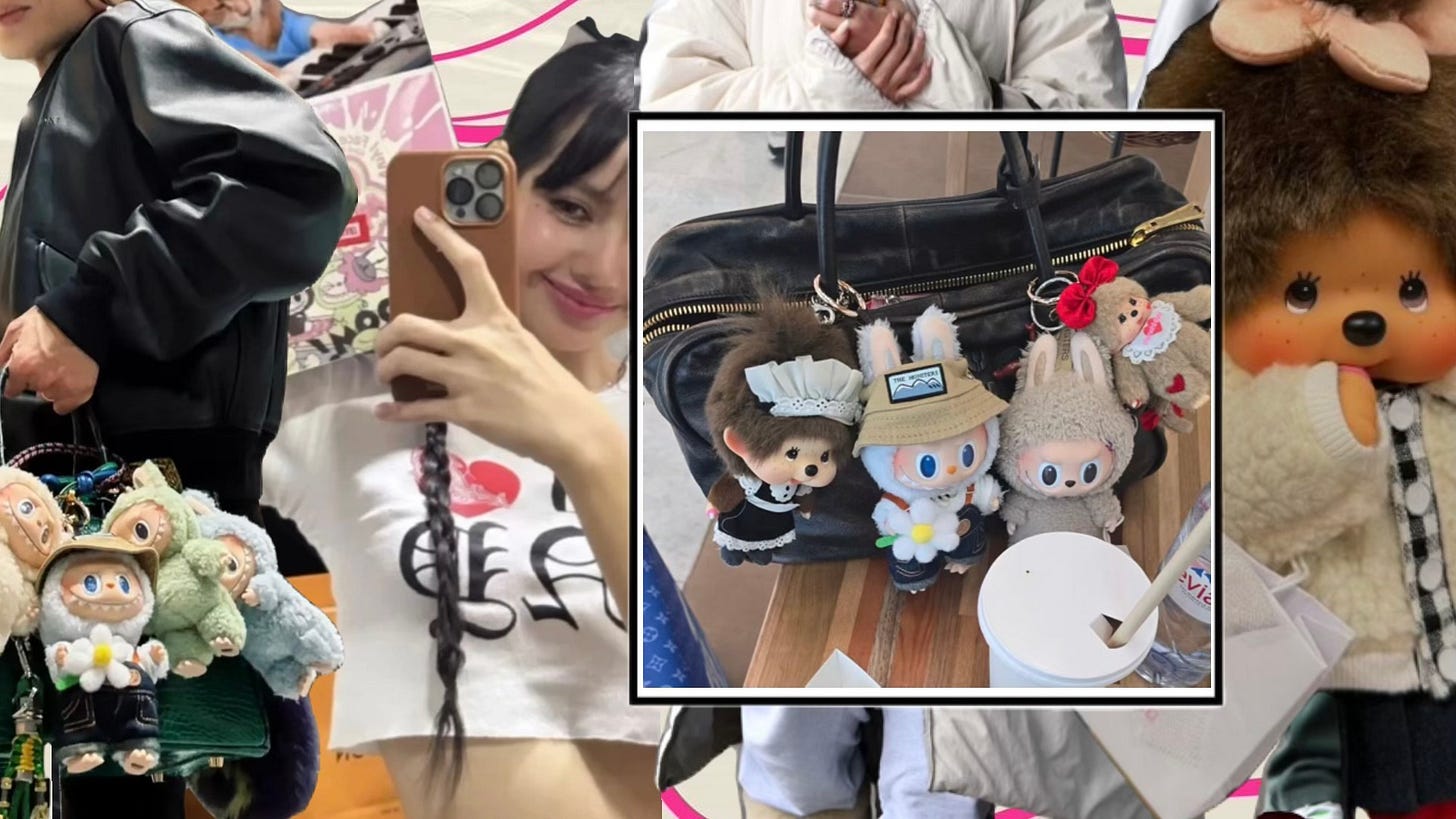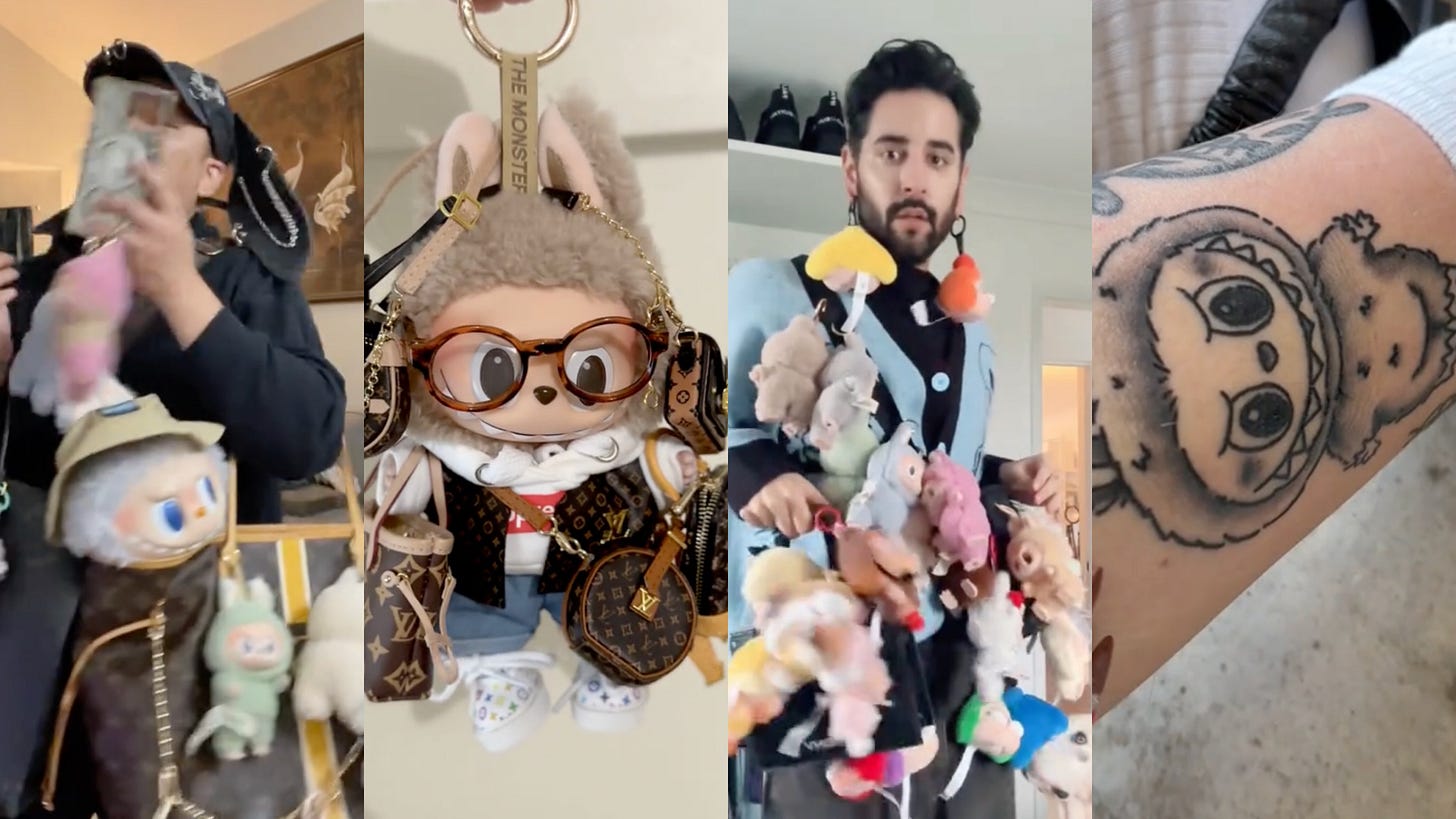Labubu, Monchhichi, And The Cult of Collectors
Collectable fandoms are causing a fashion frenzy, it’s a big 2025 mood
In 2025, flexing your collectable collection is as much about community as it is about fashion clout. No one knows this better than the subculture fandoms and fanatics putting Labubu and Monchhichi into the spotlight.
City streets are no longer just buzzing — they’re jinglejangling. That clinking, chiming, oddly rhythmic noise? It’s the sound of charms and collectable trinkets swinging from designer bags, and at the centre of it all is one mischievous little monster: Labubu.
With the face of a gremlin, the body of a plush rabbit, and a grin that suggests it’s up to no good, Labubu has the fashion industry obsessed. These pocket-sized creatures have fans lining up in droves — sometimes camping overnight — just for the chance to snag one.
A creation of Hong Kong-born artist Kasing Lung, Labubu is part of Pop Mart’s The Monsters collection, which also includes Zimomo, Spooky, Tycoco, and Pato. But make no mistake, Labubu is the star of the show. The toy has sparked frenzied queues from Los Angeles to London, Bangkok to Jakarta, as collectors scramble to get their hands on the latest drop.
On TikTok, Weibo, and Instagram, Labubu is a status symbol, a flex. From doing a Tesco run in Labubu attire to everyday street style and now Stanley Cup collaborations and Labubu tattoos, this little monster is everywhere.
Blackpink’s Lisa, a self-proclaimed superfan, has sent the craze into overdrive — especially in Thailand, which, according to a May 2024 Nielsen report, leads global TikTok mentions of Labubu and Pop Mart. And taking it all the way overseas, Rihanna has now gotten in on the action too. We stan.
Where there’s hype, there’s hustle. A family allegedly broke into a claw machine to steal three Labubu figurines. In Singapore, a woman was fined RM16,000 for smuggling Labubu dolls from London. Meanwhile, fakes and resellers are flooding the market, turning Labubu into an underground commodity.
Labubu isn’t the only tiny plush making waves, however. In Japan, Monchhichi — the vintage monkey-like doll from the ‘70s — is having a major influencer-fueled comeback. And I’m here for it. It’s a nostalgic-meets-quirky fashion statement, and it’s creating a ripple effect across Asia.
This isn’t just about cute toys, though, it’s about dialling into cultural currency. Collectables with a fashion-stamped seal of approval signal in-group belonging, social fluency, and an understanding of micro-trends. Whether Team Labubu or Team Monchhichi, if you know, you know. And if you don’t? Well, good luck getting your hands on one.
The Deep Dive
Where did it all start?
Back in 2015, Hong Kong-born artist Kasing Lung dreamed up Labubu as part of The Monsters, a quirky crew inspired by Nordic folklore. Originally drawn into children’s books alongside characters like Zimomo and Tycoco, these creatures had a quiet start. That all changed in 2019 when Lung partnered with Pop Mart, China’s undisputed king of blind-box collectables.
Since then, Labubu has transformed from a niche fairytale creature into a full-blown cultural phenomenon. Available in vinyl figures, plush dolls, and endless limited-edition variants, the tiny gremlin-like character has amassed a devoted fanbase across Asia and beyond.
And the numbers back up the hype: in the first half of 2024, Pop Mart’s revenue outside mainland China hit $189 million — a 259.6% year-over-year increase — with nearly 30% of its earnings now coming from global markets. Stores have popped up everywhere from the U.S. and U.K. to South Korea, Singapore, Thailand, Vietnam, and Australia, with blind-box vending machines spreading the addiction even further.
While Labubu dominates the new-school collectables scene, Monchhichi, the OG fuzzy friend, is having a golden anniversary moment. First created in 1974 by Japan’s Sekiguchi Inc., this wide-eyed, thumb-sucking figure has sold over 70 million units across 30+ countries and remains a powerful symbol of kawaii culture to this day.
Labubu and Monchhichi aren’t just toys — they’re status symbols, nostalgia triggers, and viral fashion accessories. Whether hanging from a designer handbag, featured in an influencer’s unboxing video, or selling out in seconds at Pop Mart, these characters are shaping global trends. The lesson? Cuteness isn’t just an art — it’s an economy. And right now, cute tiny monsters run the show.
What’s the look, the feel, the vibe?
It was only a matter of time before fashion crossed over with collectables. Entire clothing stores now sell Labubu-sized outfits, and creators are dressing up their Labubu’s and labelling them Prada girls, turning feeds into miniature fashion weeks.
And where Monchhichi is concerned, head-to-toe inspired outfits, trend debriefs and bag charm overload sees the cutesy character establish its own lane in the fashion spotlight.
The general rule? The more OTT, the better. Think: maximalism meets Y2K, where hyper-cute aesthetics rule. It combines a growing love for DIY with customisation and personal storytelling, allowing our inanimate collectables to get a wardrobe upgrade. Have we reached peak personalisation? Probably. Are we stopping? Absolutely not.
In a move that proves toys are the new luxury collab, Pronounce, the avant-garde label co-founded by Zhou Jun, became the first designer brand to partner with Labubu. The collab debuted during Milan Men’s Fashion AW24 and in Shanghai, a life-sized Labubu in Pronounce’s signature purple took over the windows of Assemble by Réel, a multi-brand luxury retailer.
Not to be outdone, Sandy Liang dropped her own Monchhichi design for her brand’s 10th anniversary. Dressed in the brand head-to-toe, the fuzzy ‘70s icon got a 2024 refresh — proof that childhood relics are being remixed, rebranded, and elevated to fashion must-haves.
If you know, you know…
There’s something about Labubu that turns rational adults into wide-eyed, adrenaline-fueled collectors. And Pop Mart knows exactly how to feed the obsession.
Labubu comes in all shapes and sizes: plush toys, mega-sized figurines, and, most dangerously, blind boxes — where you don’t know what you’re getting until you open it. Some variations are standard, others are treasured rarities. For desperate collectors wanting to get their hands on something, anything, turning to resale has become the only option to satisy their desire.
And therein lies the genius. The scarcity, the unpredictability, the sheer thrill of the chase — all of it fuels an addiction where owning the toy is only half the agenda. The other half? The hunt. That’s what keeps people coming back for more.
It’s worth noting that these designer toys aren’t meant for play, they’re made for display. This new age symbolism thrives on curation and a collector mindset, drawing in a crowd of kidults with disposable income and a taste for childhood indulgences that they can show off.
The message is clear: to collect is to belong. And in a world where scarcity equals status, Labubu and Monchhichi have a cultural power that’s hard to replicate.
Who’s leading this subculture charge?
Who would have thought; Thai actor and model Mario Maurer, Singaporean politician Lam Pin Min, and Vietnamese supermodel Thanh Hằng share a Labubu obsession. The sharp-toothed, pointy-eared gremlin has infiltrated the highest echelons of pop culture and power.
Keep reading with a 7-day free trial
Subscribe to Fashion Tingz to keep reading this post and get 7 days of free access to the full post archives.






